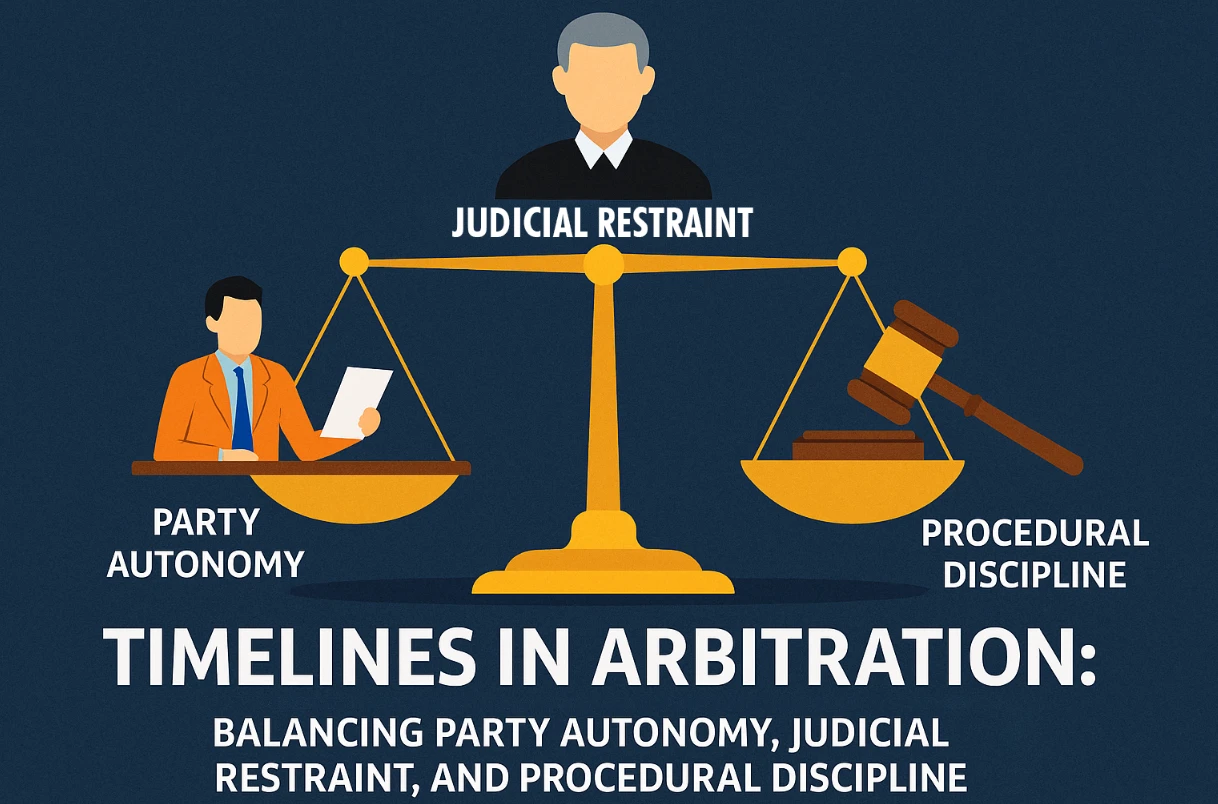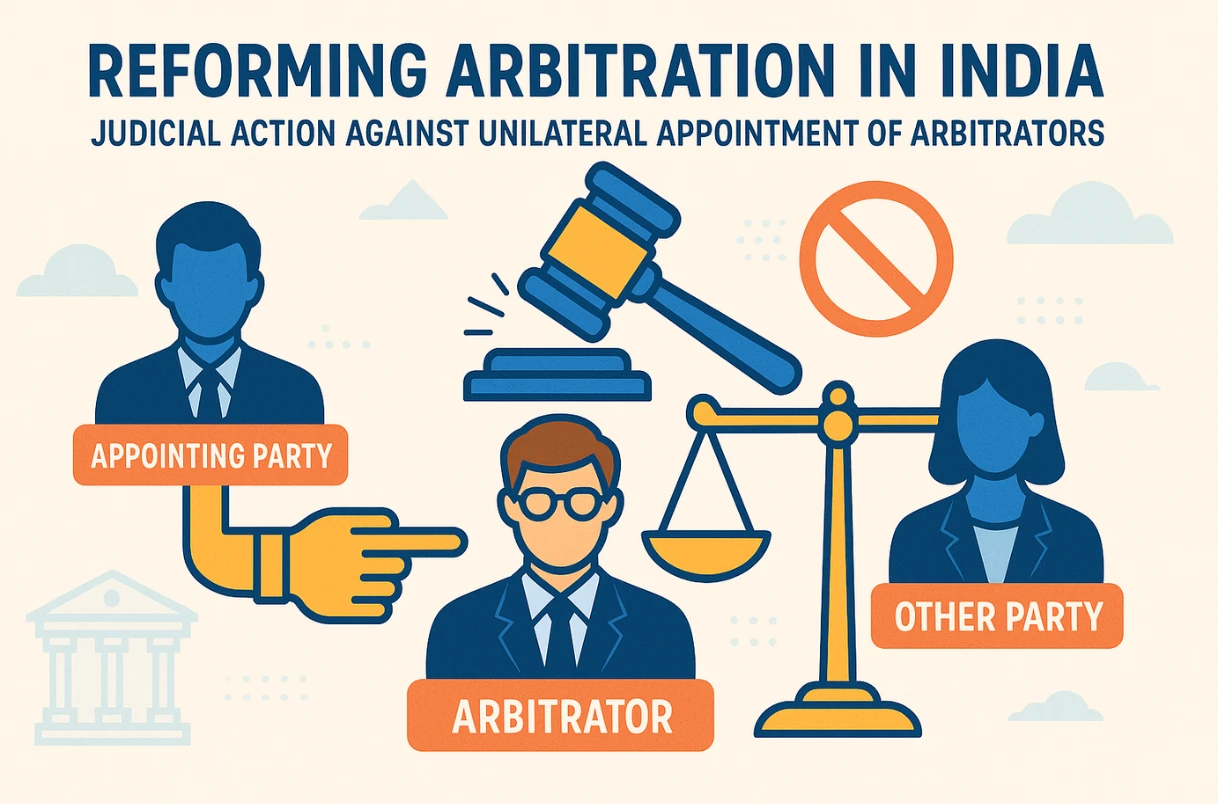Timelines in Arbitration: Balancing Party Autonomy, Judicial Restraint, and Procedural Discipline

By – Astha Sharma and Nikhil Anand
Table of Contents
Introduction: Party Autonomy and Procedural Discipline in Arbitration
The Arbitration and Conciliation Act, 1996 was enacted to provide a modern framework for arbitration in India, aligning it with international practices and the UNCITRAL Model Law. At the heart of the Act lies the principle of party autonomy: the idea that parties to a contract should be free to determine how their disputes will be resolved, including the procedure and timelines governing arbitral proceedings. Section 23 of the Act expressly recognises this autonomy, allowing parties to decide the time limits for filing of pleadings. Where parties choose institutional arbitration, such as under the aegis of Delhi International Arbitration Centre (DIAC), Mumbai Centre for International Arbitration (MCIA), Indian Counsel of Arbitration (ICA), Society for Affordable Redressal of Disputes (SAROD), etc. the rules of such institutions, respectively, become binding, reflecting a conscious decision to be bound by such rules, which promotes procedural discipline and transparency.
Case Focus: Aneja Constructions v. Doosan Power Systems
Arbitration procedural discipline recently came under scrutiny in Aneja Constructions India Ltd. v. Doosan Power Systems India Pvt. Ltd., decided by the Delhi High Court on 6 August 20251, wherein the parties had chosen ICA Rules for the conduct of their arbitration proceedings, which inter alia provides for a maximum of 60 day period for filing the Statement of Defence. When the Respondent therein filed its Statement of Defence beyond the timeline of 60 days, the Claimant challenged the same as being contrary to the timelines. It was argued that by adopting the ICA Rules for arbitration timelines, any filing beyond the chosen arbitration procedure was impermissible. The tribunal, however, allowed the delayed Statement of Defence in the “interests of justice”. Even the High Court refused to interfere under Article 227 of the Constitution, highlighting judicial restraint in arbitration matters by holding that judicial review over procedural orders in arbitration should be exercised only in rare cases involving perversity, bad faith, or patent lack of jurisdiction.
Balancing Justice and Discipline in Arbitral Timelines
This approach reflects a broader tension in timelines in arbitration in India: while party autonomy and procedural discipline demand adherence to agreed timelines, tribunals and courts often invoke the principle of “procedure is the handmaid of justice” to allow some flexibility. As arbitration is increasingly becoming the preferred mode of dispute resolution for commercial disputes in India, questions often arise with respect to timelines in arbitration proceedings in India, arbitration procedure and delay, judicial intervention, etc. The same often undermines the core objectives of arbitration in terms of speedy resolution, finality, and minimal judicial intervention.
Judicial Restraint and Article 227: A Consistent Approach
Indian courts have repeatedly emphasised the need for judicial restraint in arbitration. In Deep Industries Ltd. v. ONGC Ltd. (2020)2 and Bhaven Construction v. Sardar Sarovar Narmada Nigam Ltd. (2022)3, the Supreme Court held that Article 227 jurisdiction must be used sparingly in arbitration, limited to instances of perversity, bad faith, or orders passed without jurisdiction. Routine procedural directions, including extensions of time for pleadings, are not to be interfered with, lest arbitration become bogged down by satellite litigation. The Delhi High Court in Aneja Constructions applied these principles, observing that arbitral efficiency and fairness would collapse, if every procedural extension becomes the subject of judicial review.
Expanding the Principle: The Jindal Steel Case
A similar approach emerged in M/s Jindal Steel and Power Ltd. v. M/s Bansal Infra Projects Pvt. Ltd.4, decided by the Orissa High Court on 20 August 2024 and later affirmed by the Supreme Court in 2025. The dispute concerned an injunction against the invocation of a bank guarantee under Section 9 of the Arbitration Act. Despite an appellate remedy being available under Section 37, the writ petition was preferred under Article 227. Both the High Court and Supreme Court cautioned against such parallel proceedings, stressing that the Arbitration Act is a self-contained code and that constitutional remedies must not be used to bypass statutory mechanisms. The consistent judicial restraint across these cases highlights the courts do not in normal and regular course want to interfere in arbitration proceedings, maintaining party autonomy in arbitration and promoting efficiency and fairness in arbitration proceedings.
Persistent Challenge: Delay in Arbitration Proceedings
However, while courts are cautions in exercising judicial intervention in arbitration proceedings, but delay in arbitration procedure remains a key pain point in various arbitration matters. Arbitration and Conciliation Act, 1996, while permitting tribunals to conduct proceedings flexibly, also promotes party autonomy. Section 25(b) of the Arbitration and Conciliation Act, 1996 empowers tribunals to forfeit the right to file a Statement of Defence if the respondent defaults without sufficient cause. Various institutional rules reinforce this discipline, thus reflecting the legislative and contractual intent to prevent arbitration from descending into the very delays it was designed to avoid.
Tension Between Party Autonomy and Tribunal Discretion
In Aneja Constructions, the tribunal condoned a delay far beyond the prescribed period, holding that rules exist to advance justice, not to thwart it. The High Court endorsed this reasoning, noting that absent bad faith or perversity, such procedural orders fell within the tribunal’s discretion and did not interfere which would have led to further delay. While on one hand such approach is positive in terms of lack of judicial intervention in arbitration procedural orders, but on the other hand raises concerns about party autonomy. Once the parties to the arbitration decide on a certain procedure, either by way of ad-hoc arbitration or by way of institution arbitration and the rules thereof, the same should be adhered to. Parties agree to arbitration and often to specific institutional frameworks for the want of time-bound resolution and the same deserves to be protected.
Risks of Procedural Flexibility
Excessive leniency can incentivise procedural abuse. Parties may on purpose delay filing their defence to pressure the other side into settlement or to prolong proceedings strategically. Each extension pushes back hearings, extends timelines in conclusion of arbitrations, and ultimately, the award itself. Justice delayed, in such circumstances, also becomes justice denied.
Striking the Balance: Maintaining Procedural Discipline
It is therefore important for the tribunals and courts to strike a careful balance so that arbitration procedural discipline can be maintained. The principle that “procedure is the handmaid of justice” should not be stretched to the point where procedure becomes meaningless altogether.
International arbitration practice offers useful guidance. Leading institutions such as the ICC and SIAC impose strict timelines for pleadings, rarely extended absent exceptional circumstances. Tribunals are empowered to proceed ex parte or forfeit rights if parties default without cause. Indian arbitration, to remain globally competitive, must move in a similar direction towards greater procedural discipline without sacrificing arbitration efficiency and fairness.
Conclusion: Towards a Calibrated Framework
The solution may lie in a calibrated framework. First, contractual timelines under institutional rules should be treated as binding unless both parties consent to their relaxation. Second, any extension by the tribunal should require written reasons demonstrating exceptional circumstances rather than routine convenience. Third, judicial review must be reserved for cases involving perversity, bad faith, or violation of natural justice, not mere procedural delays. Such a framework would harmonise party autonomy, procedural efficiency, and substantive justice.
FAQs
-
What are the prescribed timelines under the Arbitration and Conciliation Act, 1996?
The Arbitration and Conciliation Act, 1996 does not prescribe rigid timelines for filing pleadings. Under Section 23, parties enjoy full autonomy to fix their own schedule for submitting the Statement of Claim and Statement of Defence. Where institutional arbitration is chosen, the timelines under those institutional rules become binding. To prevent misuse, Section 25(b) empowers the tribunal to forfeit a respondent’s right to file its defence if it defaults without sufficient cause. While procedural timelines remain flexible, Section 29A imposes a statutory outer limit an arbitral award must be made within 12 months from the completion of pleadings, extendable by six months with party consent, and thereafter only with court approval.
-
What is the significance of party autonomy in arbitration proceedings?
Party autonomy is the cornerstone of arbitration. It allows parties to determine how their disputes will be resolved including the procedure, timelines, and institutional rules such as those of ICA, DIAC, or MCIA. Once parties choose a specific framework, its timelines and procedures become binding, reflecting a conscious commitment to procedural discipline and predictability.
-
How does the Aneja Constructions case impact arbitration timelines?
In Aneja Constructions v. Doosan Power Systems India Pvt. Ltd., the parties had agreed to follow the ICA Rules, which prescribe a 60-day limit for filing the Statement of Defence. Despite this, the tribunal accepted a delayed filing “in the interest of justice,” and the Delhi High Court declined to interfere under Article 227.
The case illustrates a recurring tension between party-agreed procedural discipline and arbitral flexibility. While institutional timelines are intended to be binding, tribunals often exercise discretion in the name of fairness, raising questions about the sanctity of party autonomy. -
Can arbitral tribunals extend deadlines beyond institutional rules?
Yes, but only in exceptional circumstances. Even though institutional rules are binding once adopted, tribunals retain limited discretion to extend deadlines in the interest of justice. In Aneja Constructions, the tribunal allowed a delayed filing beyond the 60-day limit prescribed by ICA Rules, and the Delhi High Court upheld this discretion. However, frequent extensions risk undermining procedural discipline and should be granted sparingly.
-
When can courts intervene in arbitration under Article 227?
Judicial intervention under Article 227 is restricted to rare cases involving perversity, bad faith, or patent lack of jurisdiction. Routine procedural orders—including extensions of time—are not ordinarily interfered with. The Supreme Court in Deep Industries Ltd. v. ONGC Ltd. and Bhaven Construction v. Sardar Sarovar Narmada Nigam Ltd., and the Delhi High Court in Aneja Constructions, have reaffirmed this principle of judicial restraint.
-
What is the role of Section 25(b) in ensuring procedural discipline?
Section 25(b) acts as a deterrent against delay. It empowers the tribunal to forfeit a respondent’s right to file its defence if it defaults without sufficient cause. This ensures that parties adhere to agreed schedules and prevents arbitration from degenerating into the same delays that plague traditional litigation.
-
Why is judicial restraint important in arbitration proceedings?
Judicial restraint ensures that arbitration remains efficient, final, and autonomous. If courts routinely intervened in procedural matters, arbitration would become vulnerable to satellite litigation, defeating its very purpose as a faster and more flexible alternative to traditional adjudication.
-
What are the consequences of procedural delays in arbitration?
Leniency in enforcing timelines can lead to deliberate delay tactics. Parties may postpone filings to pressure settlements or gain tactical advantage. Each extension pushes back hearings, prolongs the award, and undermines the credibility of arbitration as a time-bound process. Justice delayed in such cases becomes justice denied.
-
How do international arbitration rules (ICC, SIAC) handle delays?
Institutions such as ICC and SIAC treat procedural timelines as firm commitments. Tribunals issue a detailed procedural timetable early in the proceedings, fixing deadlines for pleadings, evidence, and hearings. Extensions are granted only upon a strong and justified showing of cause. If a party defaults, tribunals may proceed without that submission or draw adverse inferences. Some institutions even hold arbitrators accountable—ICC may reduce arbitrator fees for delayed awards, while SIAC’s expedited procedure mandates issuance of awards within short timeframes. This strict discipline ensures procedural integrity and deters strategic delay.
-
What reforms can improve efficiency in Indian arbitration timelines?
Efficiency in Indian arbitration can be improved through a calibrated approach that reinforces timelines while respecting party autonomy. Institutional or contractual schedules agreed upon by the parties should be treated as binding unless both sides expressly consent to their relaxation. Tribunals must record written reasons demonstrating exceptional circumstances before extending deadlines, ensuring that extensions remain the exception, not the norm. Judicial intervention should be limited to instances of perversity, bad faith, or violation of natural justice, avoiding review of procedural delays or discretionary orders. This balanced framework will safeguard party autonomy, maintain procedural discipline, and help arbitration achieve its goal of being a time-bound and credible alternative to litigation.
References –
- CM(M) 1419/2025 & CM APPL. 46709-46710/2025.
- AIRONLINE 2019 SC 1958.
- AIRONLINE 2021 SC 6.
- W.P.(C) No.11848 of 2024.


